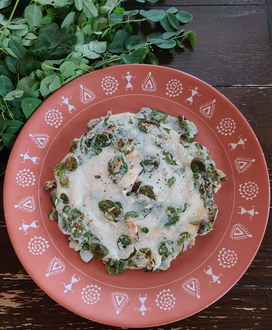MURUNGA KEERAI VARUMARISI ADAI (RICE PANCAKES WITH MORINGA LEAVES)


Varumarisi Adai literally translates to pancakes made of just rice. Rice is soaked and ground into a smooth batter with a little water and salt. Murunga keerai or Moringa leaves is added and mixed well. The thick batter is then ladled onto a hot griddle and turned into delicious and nutritious Adai or pancakes.
When you find fresh Murunga ellai/drumstick leaves/Moringa leaves in the market, you make Varmarisi Adai/pancake mixed with said leaves. The love affair doesn’t quite end there. You’ve to then eat them with some Mahani (Sarasparilla root pickle) in order to complete and revel in the magical combination of Rice pancakes, Drumstick leaves and Mahani!
Varmarisi Adai/pancake as the name suggests is made out of a batter made from only rice. In my family, a little coconut is added while grinding the batter. The coconut lends a certain softness to the batter and prevents the pancakes from drying out. Typically grated cabbage or Murangai keerai (Moringa Leaves) is added to the batter to make it more flavorful. The subtly flavored rice pancake makes a good canvas to bring out the charred and earthy flavors of the vegetables.
As I’ve already mentioned, the dish is typically served with Mahani (Sarasparilla root pickle). But anything spicy or tangy such as Chutneys, Molagapodi, pickles , pulikachal etc would make for a good accompaniment with this adai.
Check out for more Murunga keerai/Morianga leaves recipes
THIS RECIPE SERVES 6
INGREDIENTS
- Raw Rice – 3 cups
- Grated Coconut – 1 cup
- Salt – 2 tsps
- Water – 2 cups
- Murungai Ilai – 3 cups
METHOD
- Wash and soak rice in water for at least 4 hours. (Note 1)
- Pick the leaves from the stem of the moringa leaves. Keep aside. (Note 2)
- Drain the water. Grind along with the coconut, salt and adequate water into a smooth paste. I used about 2 cups of water to bring it to the desired consistency, which is thick but runny.
- Wash the leaves, squeeze out the water and simply add to the batter.
- Heat a griddle, preferably a cast-iron one. Pour a ladle full of batter to the center of the pan, run the ladle in concentric circles to make the pancake. Drizzle oil. (Note 3)
- Using the spatula, make a hole in the center to allow steam to escape. Add a drop of oil into the hole. Cook on medium-low heat. Turn over and cook on the other side until the leaves crisp up and char.
- Remove from the pan and serve hot with choice accompaniments.
NOTES
- I’ve used raw rice here. But you could use any rice of choice – sona masoori, parboiled rice, idli rice, red rice, brown rice. Refrain from using aromatic rice such as Basmati. If using red or brown rice, soak overnight. I’ve personally used sonamasoori, parboiled rice and idli rice to great success.
- I’ve used 3 cups of leaves here. But you could use as much or as little as you like.
- Typically, the batter is dense/thick and when finely chopped veggies are added to it, it takes on a semi-solid state. Balls are made and patted into discs directly onto a cold pan some oil poured around it and then the heat is turned on and the Adai cooked on both sides. But another way of making this would be to add water to bring it to a thick but runny batter-like consistency. And then ladle out batter onto a heated pan and cook on both sides. If you’d like to try out the first method, reduce the water while grinding the batter.